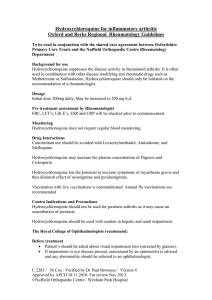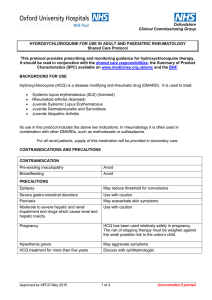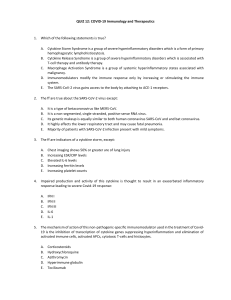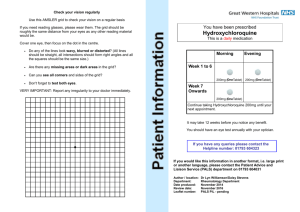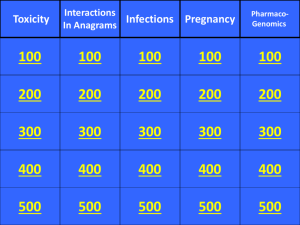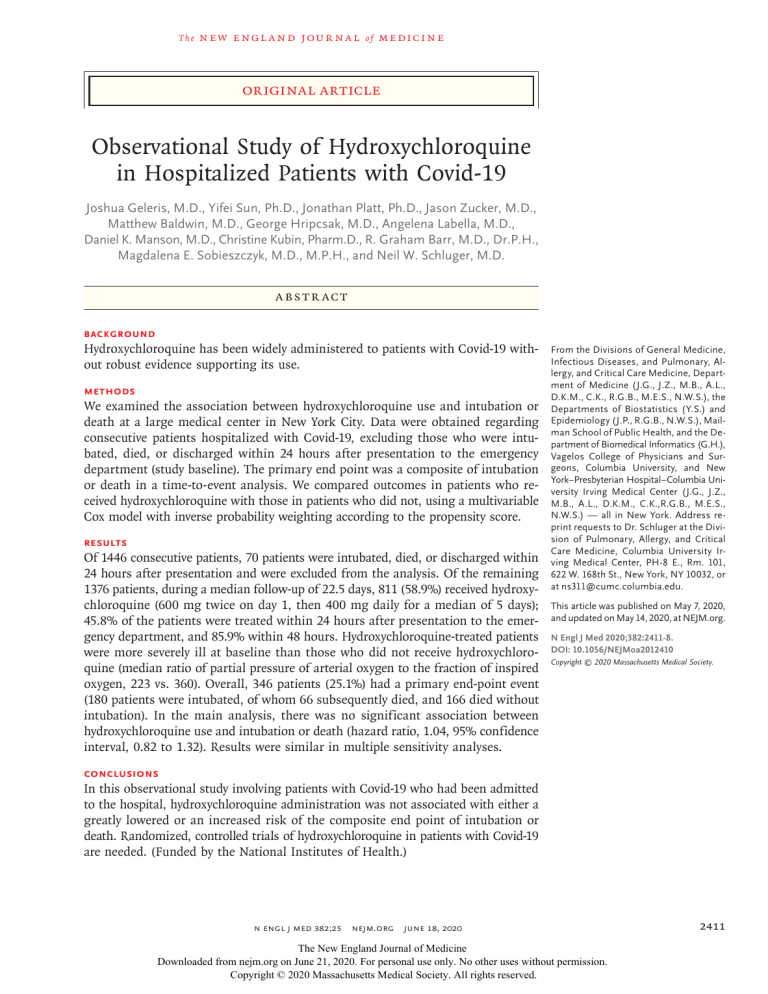
The
n e w e ng l a n d j o u r na l
of
m e dic i n e
Original Article
Observational Study of Hydroxychloroquine
in Hospitalized Patients with Covid-19
Joshua Geleris, M.D., Yifei Sun, Ph.D., Jonathan Platt, Ph.D., Jason Zucker, M.D.,
Matthew Baldwin, M.D., George Hripcsak, M.D., Angelena Labella, M.D.,
Daniel K. Manson, M.D., Christine Kubin, Pharm.D., R. Graham Barr, M.D., Dr.P.H.,
Magdalena E. Sobieszczyk, M.D., M.P.H., and Neil W. Schluger, M.D.
A BS T R AC T
BACKGROUND
Hydroxychloroquine has been widely administered to patients with Covid-19 without robust evidence supporting its use.
METHODS
We examined the association between hydroxychloroquine use and intubation or
death at a large medical center in New York City. Data were obtained regarding
consecutive patients hospitalized with Covid-19, excluding those who were intubated, died, or discharged within 24 hours after presentation to the emergency
department (study baseline). The primary end point was a composite of intubation
or death in a time-to-event analysis. We compared outcomes in patients who received hydroxychloroquine with those in patients who did not, using a multivariable
Cox model with inverse probability weighting according to the propensity score.
RESULTS
Of 1446 consecutive patients, 70 patients were intubated, died, or discharged within
24 hours after presentation and were excluded from the analysis. Of the remaining
1376 patients, during a median follow-up of 22.5 days, 811 (58.9%) received hydroxychloroquine (600 mg twice on day 1, then 400 mg daily for a median of 5 days);
45.8% of the patients were treated within 24 hours after presentation to the emergency department, and 85.9% within 48 hours. Hydroxychloroquine-treated patients
were more severely ill at baseline than those who did not receive hydroxychloroquine (median ratio of partial pressure of arterial oxygen to the fraction of inspired
oxygen, 223 vs. 360). Overall, 346 patients (25.1%) had a primary end-point event
(180 patients were intubated, of whom 66 subsequently died, and 166 died without
intubation). In the main analysis, there was no significant association between
hydroxychloroquine use and intubation or death (hazard ratio, 1.04, 95% confidence
interval, 0.82 to 1.32). Results were similar in multiple sensitivity analyses.
From the Divisions of General Medicine,
Infectious Diseases, and Pulmonary, Allergy, and Critical Care Medicine, Department of Medicine (J.G., J.Z., M.B., A.L.,
D.K.M., C.K., R.G.B., M.E.S., N.W.S.), the
Departments of Biostatistics (Y.S.) and
Epidemiology (J.P., R.G.B., N.W.S.), Mailman School of Public Health, and the Department of Biomedical Informatics (G.H.),
Vagelos College of Physicians and Surgeons, Columbia University, and New
York–Presbyterian Hospital–Columbia University Irving Medical Center (J.G., J.Z.,
M.B., A.L., D.K.M., C.K.,R.G.B., M.E.S.,
N.W.S.) — all in New York. Address reprint requests to Dr. Schluger at the Division of Pulmonary, Allergy, and Critical
Care Medicine, Columbia University Irving Medical Center, PH-8 E., Rm. 101,
622 W. 168th St., New York, NY 10032, or
at ­ns311@­cumc.­columbia.­edu.
This article was published on May 7, 2020,
and updated on May 14, 2020, at NEJM.org.
N Engl J Med 2020;382:2411-8.
DOI: 10.1056/NEJMoa2012410
Copyright © 2020 Massachusetts Medical Society.
CONCLUSIONS
In this observational study involving patients with Covid-19 who had been admitted
to the hospital, hydroxychloroquine administration was not associated with either a
greatly lowered or an increased risk of the composite end point of intubation or
death. Randomized, controlled trials of hydroxychloroquine in patients with Covid-19
are needed. (Funded by the National Institutes of Health.)
n engl j med 382;25
nejm.org
June 18, 2020
The New England Journal of Medicine
Downloaded from nejm.org on June 21, 2020. For personal use only. No other uses without permission.
Copyright © 2020 Massachusetts Medical Society. All rights reserved.
2411
The
n e w e ng l a n d j o u r na l
T
he aminoquinolines chloroquine
and hydroxychloroquine are widely used
in the treatment of malaria and rheumatic diseases, and they have been suggested as
effective treatments for coronavirus disease 2019
(Covid-19) on the grounds of both antiinflammatory and antiviral effects.1-4 In the United
States, the Food and Drug Administration issued
an Emergency Use Authorization on March 30,
2020, that allowed the use of these drugs in
patients with Covid-19 who were not enrolled in
clinical trials. Guidelines suggested that these
drugs be administered to hospitalized patients
who had evidence of pneumonia,5 and to date,
they have been used in many thousands of patients with acute Covid-19 around the world.
However, to date, there have been no robust
clinical trials that have shown efficacy of these
agents for this illness, and the data that are
available come from small studies that have either been uncontrolled or underpowered to detect meaningful clinical effects.
The original report of hydroxychloroquine as
a treatment for Covid-19 described 26 patients
who had been treated in an open-label, singlegroup study that involved contemporaneous, but
nonrandomized controls in hospitals in France.6
Patients were treated with hydroxychloroquine at
a dose of 200 mg three times daily for 10 days.
Data from this study were reported as showing
the effectiveness of hydroxychloroquine in reducing the viral burden in treated patients
(65.0% clearance by day 5, vs. 18.8% clearance
by day 5 in untreated patients). However, data
from 6 patients who received hydroxychloroquine were excluded from the analysis because
of clinical worsening or loss to follow-up, which
makes it difficult to interpret the findings.
Recent work suggests that hydroxychloroquine has more potent antiviral properties than
chloroquine, as well as a better safety profile.7 In
accordance with clinical guidelines developed at
our medical center, hydroxychloroquine was
suggested as treatment for hospitalized patients
with Covid-19 and respiratory difficulty, as indicated by a low resting oxygen saturation, during
the period in which patients in this report were
admitted.
We examined the association between hydroxychloroquine use and respiratory failure at a
2412
n engl j med 382;25
of
m e dic i n e
large medical center providing care to a substantial number of patients with Covid-19 in New
York City. We hypothesized that hydroxychloroquine use would be associated with a lower risk
of a composite end point of intubation or death
in analyses that were adjusted for major predictors of respiratory failure and weighted according to propensity scores assessing the probability of hydroxychloroquine use.
Me thods
Setting
We conducted this study at New York–Presbyterian Hospital (NYP)–Columbia University Irving Medical Center (CUIMC), a quaternary,
acute care hospital in northern Manhattan. We
obtained samples from all admitted adults who
had a positive test result for the virus SARSCoV-2 from analysis of nasopharyngeal or oropharyngeal swab specimens obtained at any
point during their hospitalization from March
7 to April 8, 2020. Follow-up continued through
April 25, 2020. These tests were conducted by
the New York State Department of Health until
the NYP–CUIMC laboratory developed internal
testing capability with a reverse-transcriptase–
polymerase-chain-reaction assay on March 11,
2020. Patients who were intubated, who died, or
who were transferred to another facility within
24 hours after presentation to the emergency
department were excluded from the analysis. The
institutional review board at CUIMC approved
this analysis under an expedited ­review.
A guidance developed by the Department of
Medicine and distributed to all the house staff
and attending staff at our medical center suggested hydroxychloroquine as a therapeutic option for patients with Covid-19 who presented
with moderate-to-severe respiratory illness,
which was defined as a resting oxygen saturation of less than 94% while they were breathing
ambient air. The suggested hydroxychloroquine
regimen was a loading dose of 600 mg twice on
day 1, followed by 400 mg daily for 4 additional
days. Azithromycin at a dose of 500 mg on day
1 and then 250 mg daily for 4 more days in
combination with hydroxychloroquine was an
additional suggested therapeutic option. The
azithromycin suggestion was removed on April
nejm.org
June 18, 2020
The New England Journal of Medicine
Downloaded from nejm.org on June 21, 2020. For personal use only. No other uses without permission.
Copyright © 2020 Massachusetts Medical Society. All rights reserved.
Hydroxychloroquine in Patients with Covid-19
12, 2020, and the hydroxychloroquine suggestion was removed on April 29, 2020. The decision to prescribe either or both medications was
left to the discretion of the treating team for
each individual patient.
Patients receiving sarilumab were allowed to
continue hydroxychloroquine. Patients receiving
remdesivir as part of a randomized trial either
did not receive or had completed a course of
treatment with hydroxychloroquine.
Hydroxychloroquine Exposure
Patients were defined as receiving hydroxychloroquine if they were receiving it at study baseline
or received it during the follow-up period before
intubation or death. Study baseline was defined
as 24 hours after arrival at the emergency department.
End Point
The primary end point was the time from study
baseline to intubation or death. For patients who
Data Sources
died after intubation, the timing of the primary
We obtained data from the NYP–CUIMC clinical end point was defined as the time of intubation.
data warehouse. This warehouse contains all the
clinical data available on all inpatient and outpa- Statistical Analysis
tient visits to one of the CUIMC facilities (see the We calculated bivariate frequencies to examine
Data Extraction section in the Supplementary the associations among the preadmission variAppendix, available with the full text of this article ables described above. Patients without a priat NEJM.org). No data were manually abstracted mary end-point event had their data censored on
from the electronic medical record or charts. The April 25, 2020.
data obtained included patients’ demographic
Cox proportional-hazards regression models
details, insurance status, vital signs, laboratory were used to estimate the association between
test results, medication administration data, his- hydroxychloroquine use and the composite end
torical and current medication lists, historical and point of intubation or death. An initial multicurrent diagnoses, clinical notes, historical dis- variable Cox regression model included democharge disposition for previous inpatient hospi- graphic factors, clinical factors, laboratory tests,
talizations, and ventilator use data.
and medications. In addition, to help account for
the nonrandomized treatment administration of
Variables Assessed
hydroxychloroquine, we used propensity-score
From the clinical data warehouse, we obtained methods to reduce the effects of confounding.
the following data elements for each patient: The individual propensities for receipt of hyage; sex; patient-reported race and ethnic group; droxychloroquine treatment were estimated with
current insurance carrier; the first recorded vital the use of a multivariable logistic-regression
signs on presentation; the ratio of the partial model that included the same covariates as the
pressure of arterial oxygen to the fraction of Cox regression model. Associations between
inspired oxygen (Pao2:Fio2) at admission, esti- hydroxychloroquine use and respiratory failure
mated with the use of methods developed by were then estimated by multivariable Cox regresBrown and colleagues8,9 (see the Data Extraction sion models with the use of three propensitysection in the Supplementary Appendix); the score methods.
The primary analysis used inverse probability
first recorded body-mass index as calculated for
measured height and weight (the body-mass in- weighting. In the inverse-probability-weighted
dex is the weight in kilograms divided by the analysis, the predicted probabilities from the
square of the height in meters), grouped on the propensity-score model were used to calculate
basis of the Centers for Disease Control and the stabilized inverse-probability-weighting
Prevention guidelines for adults; the first re- weight.10 Kaplan–Meier curves and Cox models
corded inpatient laboratory tests; past and cur- that used the inverse-probability-weighting
rent diagnoses; patient-reported smoking status; weights were reported.
and medication administration at baseline. DeWe conducted a secondary analysis that used
tails of the variables assessed are provided in the propensity-score matching and another that inSupplementary Appendix.
cluded the propensity score as an additional covari-
n engl j med 382;25
nejm.org
June 18, 2020
The New England Journal of Medicine
Downloaded from nejm.org on June 21, 2020. For personal use only. No other uses without permission.
Copyright © 2020 Massachusetts Medical Society. All rights reserved.
2413
The
n e w e ng l a n d j o u r na l
ate. In the propensity-score matching analysis,
the nearest-neighbor method was applied to
create a matched control sample. Additional sensitivity analyses included the same set of analyses with the use of a different study baseline of
48 hours after arrival to the emergency department as well as analyses that defined the exposure as receipt of the first dose of hydroxychloroquine before study baseline only. Multiple
imputation was used to handle missing data,
and model estimates and standard errors were
calculated with Rubin’s rules.11 The nonparametric bootstrap method was used to obtain 95%
pointwise confidence intervals for the inverseprobability-weighted Kaplan–Meier curves. The
statistical analyses were performed with the use
of R software, version 3.6.1 (R Project for Statistical Computing).
R e sult s
Characteristics of the Cohort
Of 1446 consecutive patients with Covid-19 who
were admitted to the hospital between March 7
and April 8, 2020, a total of 70 patients were excluded from this study because they had already
had intubation or death, were discharged after
inpatient admission, or were directly admitted to
alternative facilities within 24 hours after presentation to the emergency department. Thus, 1376
patients were included in the analysis (Fig. 1).
1446 Adult patients were admitted with
Covid-19 during the study period
70 Were excluded
26 Were intubated before study
baseline
28 Were intubated and died
before study baseline
3 Died before study baseline
13 Were transferred to other
facility before study baseline
1376 Were included in the propensityscore–matched and regression analyses
Figure 1. Study Cohort.
Study baseline was defined as 24 hours after arrival at the emergency department. Covid-19 denotes coronavirus disease 2019.
2414
n engl j med 382;25
of
m e dic i n e
Over a median follow-up of 22.5 days, 346
patients (25.1%) had a primary end-point event
(166 patients died without being intubated, and
180 were intubated). At the time of data cutoff
on April 25, a total of 232 patients had died (66
after intubation), 1025 had survived to hospital
discharge, and 119 were still hospitalized (only
24 of whom were not intubated) (Table S1 in the
Supplementary Appendix).
Of the 1376 patients, 811 (58.9%) received
hydroxychloroquine (median duration of treatment, 5 days) and 565 (41.1%) did not. Among
the patients who received hydroxychloroquine,
45.8% received it in the 24 hours between their
presentation to the emergency department and
the start of study follow-up, and 85.9% received
it within 48 hours after presentation to the
emergency department. The timing of the first
dose of hydroxychloroquine after presentation
to the medical center is shown in Figure S3.
The distribution of the patients’ baseline characteristics according to hydroxychloroquine exposure is shown in Table 1, both in the unmatched and propensity-score–matched analytic
samples. In the unmatched sample, hydroxychloroquine exposure differed according to age
group, sex, race and ethnic group, body-mass
index, insurance, smoking status, and current
use of other medications. Hydroxychloroquinetreated patients had a lower Pao2:Fio2 at baseline than did patients who did not receive hydroxychloroquine (median, 233 vs. 360 mm Hg).
In addition to the 27 patients listed in Table 1
who received remdesivir according to compassionate use, 30 patients in the study cohort
were enrolled in randomized, blinded, placebocontrolled trials of that investigational agent or
of sarilumab.
The distribution of the estimated propensity
scores for receipt of hydroxychloroquine among
patients who did and did not receive hydroxychloroquine is shown in Figure S1. The odds
ratios (with 95% confidence intervals) for receipt
of hydroxychloroquine according to all the variables included in the propensity-score model are
shown in Table S2. The C-statistic of the propensity-score model was 0.81. In the matched analytic sample, 811 patients were exposed to hydroxychloroquine and 274 were not exposed. The
differences between hydroxychloroquine and pre-
nejm.org
June 18, 2020
The New England Journal of Medicine
Downloaded from nejm.org on June 21, 2020. For personal use only. No other uses without permission.
Copyright © 2020 Massachusetts Medical Society. All rights reserved.
Hydroxychloroquine in Patients with Covid-19
treatment variables were attenuated in the pro- in French hospitals are difficult to interpret,
pensity-score–matched samples as compared with given the small size of that study, the lack of a
the unmatched samples (Table 2 and Fig. S2).
randomized control group, and the omission of
6 patients from the analysis.6 A clinical trial
Study End Points
testing two doses of chloroquine in patients
Among the 1376 patients included in the analy- with Covid-19 planned to include 440 patients
sis, the primary end point of respiratory failure but was halted after 81 patients had been endeveloped in 346 patients (25.1%); a total of 180 rolled because of excessive QTc prolongation and
patients were intubated, and 166 died without an indication of higher mortality in the highintubation. In the crude, unadjusted analysis, dose group (in which patients received 600 mg
patients who had received hydroxychloroquine twice daily for 10 days) than in the low-dose
were more likely to have had a primary end- group (in which patients received 450 mg daily
point event than were patients who did not for 4 days after an initial dose of 450 mg admin(hazard ratio, 2.37; 95% CI, 1.84 to 3.02) (Ta- istered twice on the first day).12
ble 2). In the primary multivariable analysis with
Two small, randomized trials from China
inverse probability weighting according to the have been reported. Physicians in Wuhan ranpropensity score, there was no significant asso- domly assigned 62 patients with mild illness
ciation between hydroxychloroquine use and the to either the control group (in which patients
composite primary end point (hazard ratio, 1.04; could receive supplemental oxygen, unspecified
95% CI, 0.82 to 1.32) (Fig. 2). There was also no antiviral agents, antibiotic agents, and immune
significant association between treatment with globulin, with or without glucocorticoids) or the
azithromycin and the composite end point (haz- experimental group (in which patients also reard ratio, 1.03; 95% CI, 0.81 to 1.31).
ceived 400 mg of hydroxychloroquine daily).
Additional multivariable propensity-score This report has not yet been fully peer-reviewed,
analyses yielded similar results (Table 2). Multi- but results were posted to the MedRxiv website
ple additional sensitivity analyses, including analy­ for public comment.13 Investigators reported a
ses that used a different baseline at 48 hours faster mean time to clinical recovery (resoluafter presentation and analyses with treatment tion of fever and cough and improvement on
defined as receipt of the first dose of hydroxy- chest radiography) in the experimental group
chloroquine before study baseline, showed simi- than in the control group. Four patients (all in
lar results (Table S3).
the control group) had progression to severe
infection. A small, randomized trial involving 30
patients in Shanghai reported on outcomes in
Discussion
patients treated with 400 mg of hydroxychloroIn this analysis involving a large sample of con- quine daily for 5 days, as compared with a consecutive patients who had been hospitalized with trol group in which patients received “convenCovid-19, the risk of intubation or death was not tional treatment only.”14 This trial showed that
significantly higher or lower among patients by day 7, a total of 86% of the patients in the
who received hydroxychloroquine than among hydroxychloroquine-treated group and 93% of
those who did not (hazard ratio, 1.04; 95% CI, those in the control group had negative results
0.82 to 1.32). Given the observational design and on viral throat swabs. All the patients in this
the relatively wide confidence interval, the study trial also received aerosolized interferon alfa by
should not be taken to rule out either benefit or nebulizer.
harm of hydroxychloroquine treatment. However,
A randomized clinical trial is the best apour findings do not support the use of hydroxy- proach to determine whether benefit can be aschloroquine at present, outside randomized clin- cribed to any given therapeutic intervention beical trials testing its efficacy.
cause this trial design minimizes the two major
As we noted in the introduction, the findings problems inherent in observational studies: unfrom an early study showing a benefit of hydroxy- measured confounding and bias. With the anachloroquine in 26 patients who had been treated lytic approaches we used in this examination of
n engl j med 382;25
nejm.org
June 18, 2020
The New England Journal of Medicine
Downloaded from nejm.org on June 21, 2020. For personal use only. No other uses without permission.
Copyright © 2020 Massachusetts Medical Society. All rights reserved.
2415
The
n e w e ng l a n d j o u r na l
of
m e dic i n e
Table 1. Characteristics of Patients Receiving or Not Receiving Hydroxychloroquine, before and after Propensity-Score Matching.*
Characteristic
Unmatched Patients
Hydroxychloroquine
(N = 811)
Propensity-Score–Matched Patients†
No Hydroxychloroquine
(N = 565)
Hydroxychloroquine
(N = 811)
No Hydroxychloroquine
(N = 274)
Age — no. (%)
<40 yr
80 (9.9)
105 (18.6)
80 (9.9)
28 (10.2)
40–59 yr
217 (26.8)
142 (25.1)
217 (26.8)
69 (25.2)
60–79 yr
367 (45.3)
220 (38.9)
367 (45.3)
118 (43.1)
≥80 yr
147 (18.1)
98 (17.3)
147 (18.1)
59 (21.5)
337 (41.6)
258 (45.7)
337 (41.6)
113 (41.2)
Non-Hispanic white
74 (9.1)
57 (10.1)
97 (12.0)
36 (13.1)
Non-Hispanic black
89 (11.0)
92 (16.3)
120 (14.8)
40 (14.6)
412 (50.8)
286 (50.6)
530 (65.4)
172 (62.8)
48 (5.9)
36 (6.4)
64 (7.9)
26 (9.5)
188 (23.2)
94 (16.6)
13 (1.6)
13 (2.3)
Female sex — no. (%)
Race and ethnic group — no. (%)‡
Hispanic
Other
Missing data
0
0
Body-mass index — no. (%)§
<18.5
18 (2.2)
7 (2.6)
18.5–24.9
147 (18.1)
98 (17.3)
184 (22.7)
53 (19.3)
25.0–29.9
224 (27.6)
157 (27.8)
279 (34.4)
96 (35.0)
30.0–39.9
218 (26.9)
133 (23.5)
268 (33.0)
99 (36.1)
52 (6.4)
20 (3.5)
62 (7.6)
19 (6.9)
157 (19.4)
144 (25.5)
≥40.0
Missing data
0
0
Insurance — no. (%)
Medicaid
165 (20.3)
146 (25.8)
166 (20.5)
54 (19.7)
Medicare
396 (48.8)
261 (46.2)
399 (49.2)
141 (51.5)
79 (9.7)
49 (8.7)
79 (9.7)
29 (10.6)
166 (20.5)
106 (18.8)
167 (20.6)
50 (18.2)
5 (0.6)
3 (0.5)
89 (11.0)
68 (12.0)
89 (11.0)
32 (11.7)
146 (18.0)
105 (18.6)
146 (18.0)
49 (17.9)
No insurance
Commercial insurance
Missing data
Current smoking — no. (%)
0
0
Past diagnoses — no. (%)
Chronic lung disease¶
Diabetes
301 (37.1)
190 (33.6)
301 (37.1)
94 (34.3)
Hypertension
398 (49.1)
38 (6.7)
398 (49.1)
146 (53.3)
Cancer
109 (13.4)
67 (11.9)
109 (13.4)
35 (12.8)
Chronic kidney disease
133 (16.4)
105 (18.6)
133 (16.4)
61 (22.3)
40 (4.9)
18 (3.2)
40 (4.9)
11 (4.0)
Transplantation, HIV infection, or
immune-suppressive medications
Medications at baseline — no. (%)
Statin
308 (38)
197 (34.9)
308 (38)
ACE inhibitor or ARB
236 (29.1)
142 (25.1)
236 (29.1)
85 (31.0)
Systemic glucocorticoid
216 (26.6)
57 (10.1)
216 (26.6)
42 (15.3)
Direct oral anticoagulant or warfarin
107 (39.1)
76 (9.4)
47 (8.3)
76 (9.4)
24 (8.8)
Azithromycin
486 (59.9)
127 (22.5)
486 (59.9)
102 (37.2)
Other antibiotic agent
604 (74.5)
305 (54.0)
604 (74.5)
183 (66.8)
Tocilizumab
58 (7.2)
12 (2.1)
58 (7.2)
9 (3.3)
Remdesivir
22 (2.7)
5 (0.9)
22 (2.7)
5 (1.8)
125 (111–139)
127 (111–144)
125 (111–139)
126 (110–138)
Initial vital signs — median (IQR)
Systolic blood pressure — mm Hg
2416
n engl j med 382;25
nejm.org
June 18, 2020
The New England Journal of Medicine
Downloaded from nejm.org on June 21, 2020. For personal use only. No other uses without permission.
Copyright © 2020 Massachusetts Medical Society. All rights reserved.
Hydroxychloroquine in Patients with Covid-19
Table 1. (Continued.)
Characteristic
Unmatched Patients
Hydroxychloroquine
(N = 811)
Propensity-Score–Matched Patients†
No Hydroxychloroquine
(N = 565)
Hydroxychloroquine
(N = 811)
No Hydroxychloroquine
(N = 274)
Diastolic blood pressure — mm Hg
75 (67–82)
76 (68–84)
75 (67–82)
74 (65–83)
Heart rate — beats/min
98 (86–111)
97 (83–109)
98 (86–111)
97 (84–108)
94.5 (92–96)
Oxygen saturation — %
94 (90–96)
96 (94–98)
94 (90–96)
Respiratory rate — breaths/min
20 (18–22)
18 (18–20)
20 (18–22)
19.5 (18–22)
223 (160–303)
360 (248–431)
223 (160–303)
273 (185–360)
Calculated PaO2:FIO2
Initial laboratory tests — median (IQR)‖
1.25 (0.76–2.28)
1.1 (0.59–2.35)
1.26 (0.76–2.29)
1.33 (0.66–2.45)
Ferritin — ng/ml
D-Dimer
— μg/ml
785 (420–1377)
481 (213–989)
777 (417–1370)
552 (283–1095)
Lactate dehydrogenase — U/liter
414 (322–546)
333 (246–448)
412 (321–544)
370 (273–515)
125 (75–199)
76 (20–150)
125 (74–199)
106 (48–183)
Procalcitonin — ng/ml
C-reactive protein — mg/liter
0.21 (0.11–0.53)
0.14 (0.09–0.39)
0.21 (0.11–0.53)
0.18 (0.10–0.45)
Neutrophil count per mm3
5.06 (3.64–7.26)
4.53 (2.72–6.81)
5.05 (3.63–7.26)
4.95 (3.20–7.30)
Lymphocyte count per mm3
0.94 (0.65–1.28)
1.02 (0.64–1.47)
0.95 (0.66–1.30)
0.98 (0.68–1.37)
* ACE denotes angiotensin-converting enzyme, ARB angiotensin-receptor blocker, FIO2 fraction of inspired oxygen, HIV human immunodeficiency virus, IQR interquartile range, and PaO2 partial pressure of arterial oxygen.
† Data for patients included in the propensity-score–matched analysis were multiply imputed.
‡ Data on race and ethnic group, as reported by the patient, were obtained from the clinical data warehouse.
§ The body-mass index is the weight in kilograms divided by the square of the height in meters.
¶ Chronic lung disease was defined as chronic obstructive pulmonary disease, asthma, or chronic bronchitis.
‖ In the unmatched analysis, data on the D-dimer level were missing for 291 patients, on the ferritin level for 168, on the lactate dehydrogenase level for 153, on the C-reactive protein level for 150, on the procalcitonin level for 121, on the neutrophil count for 33, and on the lymphocyte count for 33. Multiple imputation was used to account for missing data in the propensity-score–matched analysis.
n engl j med 382;25
1.00
Probability of Being Event-free
our observational cohort, we have tried to minimize possible confounding in a variety of ways.
In the main analysis, a multivariable regression model with inverse probability weighting
according to the propensity score, there was no
significant association between hydroxychloroquine use and the risk of intubation or death.
We also performed a series of analyses using
several propensity-score approaches. Findings
were similar in multiple sensitivity analyses. The
consistency of the results across these analyses
is reassuring. In our analysis, we adjusted for
likely confounders, including age, race and ethnic group, body-mass index, diabetes, underlying kidney disease, chronic lung disease, hypertension, baseline vital signs, Pao2:Fio2, and
inflammatory markers of the severity of illness.
Despite this extensive adjustment, it is still possible that some amount of unmeasured confounding remains. Additional limitations of our
study include missing data for some variables
and potential for inaccuracies in the electronic
health records, such as lack of documentation of
smoking and coexisting illness for some pa-
No hydroxychloroquine
Hydroxychloroquine
0.75
0.50
0.25
0.00
0
5
10
15
20
25
30
Days
Figure 2. Freedom from Composite End Point of Intubation or Death.
The shaded areas represent pointwise 95% confidence intervals.
nejm.org
June 18, 2020
The New England Journal of Medicine
Downloaded from nejm.org on June 21, 2020. For personal use only. No other uses without permission.
Copyright © 2020 Massachusetts Medical Society. All rights reserved.
2417
Hydroxychloroquine in Patients with Covid-19
Table 2. Associations between Hydroxychloroquine Use and the Composite
End Point of Intubation or Death in the Crude Analysis, Multivariable Analysis,
and Propensity-Score Analyses.
Analysis
Intubation or Death
No. of events/no. of patients at risk (%)
Hydroxychloroquine
262/811 (32.3)
No hydroxychloroquine
84/565 (14.9)
Crude analysis — hazard ratio (95% CI)
2.37 (1.84–3.02)
Multivariable analysis — hazard ratio (95% CI)*
1.00 (0.76–1.32)
Propensity-score analyses — hazard ratio (95% CI)
With inverse probability weighting†
1.04 (0.82–1.32)
With matching‡
0.98 (0.73–1.31)
Adjusted for propensity score§
0.97 (0.74–1.28)
*Shown is the hazard ratio from the multivariable Cox proportional-hazards
model, with stratification according to sex, chronic lung disease, and body-mass
index, and with additional adjustment for age, race and ethnic group, insurance, current smoking, past diagnoses, current medications, vital statistics,
and laboratory tests on presentation. The analysis included all 1376 patients.
†Shown is the primary analysis with a hazard ratio from the multivariable Cox
proportional-hazards model with the same strata and covariates with inverse
probability weighting according to the propensity score. The analysis included
all the patients.
‡Shown is the hazard ratio from a multivariable Cox proportional-hazards model
with the same strata and covariates with matching according to the propensity
score. The analysis included 1085 patients (811 who received hydroxychloroquine and 274 who did not).
§Shown is the hazard ratio from a multivariable Cox proportional-hazards model
with the same strata and covariates, with additional adjustment for the propensity score. The analysis included all the patients.
References
1. Biot C, Daher W, Chavain N, et al. Design and synthesis of hydroxyferroquine
derivatives with antimalarial and antiviral
activities. J Med Chem 2006;49:2845-9.
2. Fox RI. Mechanism of action of hydroxychloroquine as an antirheumatic
drug. Semin Arthritis Rheum 1993;
23:
Suppl 1:82-91.
3. Devaux CA, Rolain JM, Colson P,
Raoult D. New insights on the antiviral
effects of chloroquine against coronavirus: what to expect for COVID-19? Int J
Antimicrob Agents 2020 March 12 (Epub
ahead of print).
4. Fantini J, Di Scala C, Chahinian H,
Yahi N. Structural and molecular modelling studies reveal a new mechanism of
action of chloroquine and hydroxychloroquine against SARS-CoV-2 infection. Int J
Antimicrob Agents 2020 April 3 (Epub
ahead of print).
5. Wilson KC, Chotirmall SH, Bai C,
Rello J. COVID-19:interim guidance on
management pending empirical evidence.
April 3, 2020 (https://www
.thoracic
.org/
covid/covid-­19-­g uidance.pdf).
2418
tients. Nonetheless, we used contemporary
methods to deal with missing data to minimize
bias. Finally, the single-center design may limit
the generalizability of these results.
Clinical guidance at our medical center has
been updated to remove the suggestion that patients with Covid-19 be treated with hydroxychloroquine. In our analysis involving a large
sample of consecutive patients who had been
hospitalized with Covid-19, hydroxychloroquine
use was not associated with a significantly
higher or lower risk of intubation or death (hazard ratio, 1.04; 95% CI, 0.82 to 1.32). The study
results should not be taken to rule out either
benefit or harm of hydroxychloroquine treatment, given the observational design and the
95% confidence interval, but the results do not
support the use of hydroxychloroquine at present, outside randomized clinical trials testing its
efficacy.
Supported in part by grants (RO1-LM006910, RO1-HL077612,
RO1-HL093081, and RO1-HL121270) from the National Institutes of Health.
Disclosure forms provided by the authors are available with
the full text of this article at NEJM.org.
We acknowledge the dedication, commitment, and sacrifice
of the staff, providers, and personnel in our institution through
the Covid-19 crisis and the suffering and loss of our patients as
well as in their families and our community.
6. Gautret P, Lagier JC, Parola P, et al.
Hydroxychloroquine and azithromycin as
a treatment of COVID-19: results of an
open-label non-randomized clinical trial.
Int J Antimicrob Agents 2020 March 20
(Epub ahead of print).
7. Yao X, Ye F, Zhang M, et al. In vitro
antiviral activity and projection of optimized dosing design of hydroxychloroquine for the treatment of severe acute
respiratory syndrome coronavirus 2
(SARS-CoV-2). Clin Infect Dis 2020 March
9 (Epub ahead of print).
8. Brown SM, Duggal A, Hou PC, et al.
Nonlinear imputation of PaO2/FIO2 from
SpO2/FIO2 among mechanically ventilated patients in the ICU: a prospective, observational study. Crit Care Med 2017;45:
1317-24.
9. Brown SM, Grissom CK, Moss M, et al.
Nonlinear imputation of Pao2/Fio2 from
Spo2/Fio2 among patients with acute respiratory distress syndrome. Chest 2016;
150:307-13.
10. Robins JM. Marginal structural models. 1998 (https://cdn1.sph.harvard.edu/
n engl j med 382;25
nejm.org
wp-­content/uploads/sites/343/2013/03/msm
-­web.pdf).
11. Rubin DB. Multiple imputation for
nonresponse in surveys. New York:John
Wiley, 1987.
12. Borba MGS, Val FFA, Sampaio VS, et
al. Effect of high vs low doses of chloroquine diphosphate as adjunctive therapy
for patients hospitalized with severe acute
respiratory syndrome coronavirus 2 (SARSCoV-2) infection: a randomized clinical
trial. JAMA Netw Open 2020;3(4):e208857.
13. Chen Z, Hu J, Zhang Z, et al. Efficacy
of hydroxychloroquine in patients with
COVID-19: results of a randomized clinical trial. MedRxiv. 2020 (https://www
.medrxiv.org/content/10.1101/2020.03.22
.20040758v3) (preprint).
14. Chen J, Liu D, Liu L, et al. A pilot study
of hydroxychloroquine in treatment of
patients with common coronavirus disease-19 (COVID-19). J Zhejiang Univ (Med
Sci) 2020 (http://www.zjujournals.com/
med/EN/10.3785/j.issn.1008-­9292.2020.03
.03).
Copyright © 2020 Massachusetts Medical Society.
June 18, 2020
The New England Journal of Medicine
Downloaded from nejm.org on June 21, 2020. For personal use only. No other uses without permission.
Copyright © 2020 Massachusetts Medical Society. All rights reserved.

